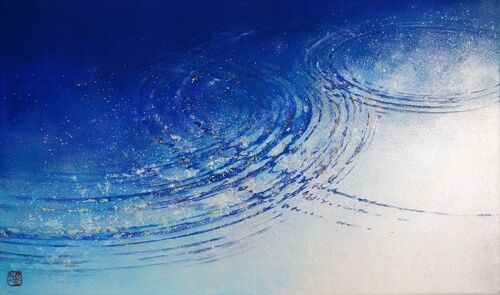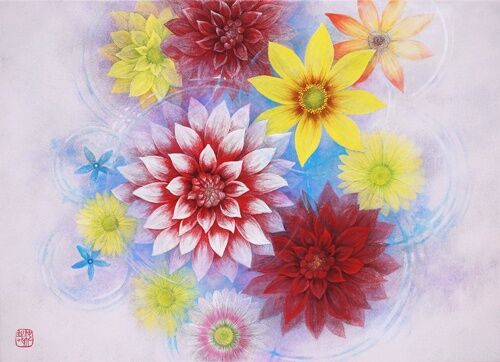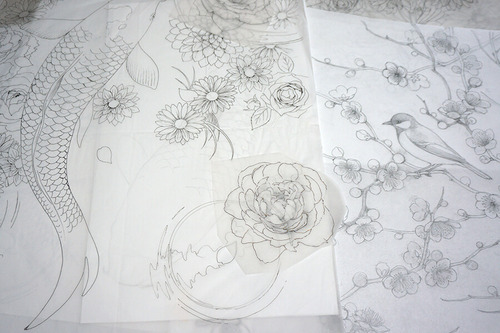- JP
- EN

We interviewed Mr. Junya Tsubota, who will hold a solo exhibition at Kintetsu Department Store in Abeno Harukas starting tomorrow, July 15 (Wed.)!

-What is the concept behind your work?
The sky and water may be said to be a universal theme.
I draw motifs that havebeen painted since ancient times, incorporating such fleeting phenomena of the sky and water.
Using the power of the colors of paint and the effect of the reflection of light from the metal foil, I aim to create works in which stillness and movement coexist.
-Please tell us what you would like viewers to see most in your works.
I hope that viewers will look at my work with a free feeling and interpretation.
There was a time when I painted abstract pictures, and even now, even when I paint figurative works, I still paint with a sense of abstraction.
I think it is interesting that the impression of the works with foil changes depending on the reflection of light, so I would like viewers to look at them from various angles.
-Have you always painted?
Actually, I did not paint much until I entered high school, and I was in the computer club at junior high school.
I was in the computer club in junior high school. The school was one of the first to adopt computers, which was unusual for my generation, and I wrote programs and drew pictures.
-When did you decide to become an artist?
When I was in high school, I joined the art club, and even though it was a regular high school, there were many seniors who went on to pursue art careers.
That’s when I decided I wanted to learn more, and that’s when I first started painting.
At first I painted oil paintings, but one day my teacher told me that Japanese-style painting was the right choice for me, and after viewing many art exhibitions, I really felt the appeal of Japanese-style painting and decided to go on to higher education.
After entering university, I was stimulated by seeing teachers and seniors who were actually active as artists, and I also challenged myself to various expressions with hope for unknown possibilities.
After leaving university, in situations where my abilities were actually put to the test, I often had to compete with a single piece of artwork, and I guess I was impatient to narrow down to one style of painting.
Gradually, he became stuck and began to doubt his ability to continue.
One year after graduating from the graduate school, I took the plunge and spent eight months abroad to shake myself up.
While learning the language and seeing many authentic works at art museums, I was able to rediscover the appeal of Japanese art and materials by being away from Japan.
And after returning to Japan, I think I was able to break free from my own spell and finally start on a theme that leads me to the present.
-How has your style changed since you returned to Japan?
Through my travels, I rediscovered the appeal of color in Japanese painting, and I changed from monotone figurative paintings to abstract works with the theme of “sky” using only line and color variation.
-You painted monotone figurative works in your early years, didn’t you?
At that time, I think I was focusing on the theme of light and shadow, and by suppressing color, I was focusing on the reality of the texture of objects and the humidity of the air.
Under Rainy Sky” F100, painted in 2000 (Aogaki 2001 Japanese Painting Exhibition, Honorable Mention)
-Tsubota’s works incorporating “water patterns” are impressive.
I used to paint the “sky” as a universal and ever-changing object.
My viewpoint gradually shifted to the sky reflected on the surface of water, and my interest shifted to the combination of ellipses (ripples) from a graphic point of view.
I began to use the power of color to express changes in light, and to express “stillness” and “movement” in contrast with metal foil.
Today, based on these motifs, the technique is being developed again, incorporating specific motifs such as carp and flowers.

Influenced by paintings of the Edo period (1603-1868), such as Rimpa paintings, he has also developed two-dimensional compositions.
Ginga no Shizuku” M6
In my figurative works, I draw “carp” and “flowers” to express the beauty of the motifs themselves, of course, but I am also strongly conscious of drawing them to express the presence of water and air around them.

skyflower” F4
-Do you actually make sketches of each motif before you create your works?
Depending on the motif, I make sketches when possible, but for fleeting phenomena such as ripples, I use photographs I took myself as a reference and add my imagination.
However, that is not enough. I usually stare at the surface of water, such as a puddle on a rainy day or a swimming pool, and burn it into my eyes.
-Please tell us about your process (including painting materials).
(1) Drawing a small sketch (Esquisse)
(2) Make a large sketch (full-size sketch)
3) Transfer and bone drawing on linen paper or silk (tracing the transferred lines with black ink)
(4) Base preparation (partially heaping up the surface to create a base)
(5) Apply foil and create matiere
(6) Coloring and painting with mineral pigments, etc.
(7) Apply gold paint, mica, etc. (repeat steps (5) to (7))
-Do you use different materials for different works, silk or Japanese paper?
I choose silk when I want to create a beautiful gradation with a thin coat of paint or when I want depth with the effect of back coloring.
-What is your main concern in your techniques?
Recently, I am particular about creating various matiere (effects on the picture skin) using foil.
I make various unevenness on the base, apply foil, and from there wash out, sprinkle sanding, and combine techniques in a complex way.
It is interesting to see the accidental expression.
-What artists and works have influenced your work?
At first, when I was painting oils in high school, I liked Millet (Barbizon School) and Impressionists.
One of the artists who inspired me to pursue Japanese painting was Kaii Higashiyama. When I saw “Evening Bell,” which depicted the tower of a large temple in Germany, I was shocked to see that Japanese paintingcould express such brightness and darkness, and I remember that my image of Japanese painting changed.
I also enjoyed watching the works of Takeuchi Seiho, Hayami Gyoshu, and others.
The more I learned about Japanese painting, the more my interest expanded to Momoyama and Edo paintings such as Kano school, Rimpa school, Hasegawa Tohaku, and Ito Jakuchu.
On the other hand, there are many contemporary artists whom I also respect.
-Tsubota-sensei, you recently appeared on the radio program “boys be ambitious” on “Ichikawa Urara FM.
I think it is rare for writers to appear in the media, but how was your experience?
It was my first time on the radio, and I was so nervous that my mind went blank (laugh).
(laughs) I felt it was difficult to explain in a limited time using only words, but it was a very good experience.
When we talk about “Japanese painting,” we tend to talk only about the characteristics of paints and other materials in order to make it easy to understand for people who do not know anything about Japanese painting.
I thought it would be more interesting to talk about my own episodes rather than give a formal explanation, so I mainly talked about that.
With Mr. Shibata, an administrative scrivener, and Ms. Matsuno, a personality.
-What is your most important attitude as an artist?
It is to always be conscious of improving the quality of my work.
In order to keep improving, I seek discoveries and realizations that exceed my imagination in each piece of work.
-What are your dreams and goals for the future?
I would like to continue to draw and pursue new expressions in my own way.
-Finally, please give a message to the people who come to see your works.
Since this exhibition is held in the summer, many of the works have a water theme.
Please come and enjoy the cool air.
Thank you very much, Professor. Tsubota!
The solo exhibition will open tomorrow, Wednesday, July 15.
This is his first solo exhibition at Abeno Harukas in two years.
Please come and see it!
Junya Tsubota -Drops of Light-”
Wednesday, July 15 – Tuesday, July 21
Venue: Abeno Harukas Kintetsu Tower, 11th Floor Art Gallery
Artist:Junya Tsubota
Artist Visits: Saturday, July 18 and Sunday, July 19, 1:00 – 5:00 p.m. each day
Junya Tsubota is a Japanese-style painter who paints a new sensory world that includes both figurative and abstract works. Having spent more than half a year in Europe after completing his graduate studies, Tsubota skillfully expresses changes in light through the power of color, even though his paintings are Japanese. Tsubota also pays homage to the paintings of the Edo period, mainly the Rimpa school. His works, in which “stillness” and “movement” coexist in contrast with ink and metal leaf, have a somewhat fantastical worldview. This is the second time to introduce his works at Abeno Harukas. We hope you will visit the exhibition.